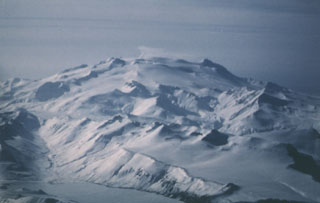Report on Makushin (United States) — January 1995
Bulletin of the Global Volcanism Network, vol. 20, no. 1 (January 1995)
Managing Editor: Richard Wunderman.
Makushin (United States) Small steam-and-ash plume reported by pilots
Please cite this report as:
Global Volcanism Program, 1995. Report on Makushin (United States) (Wunderman, R., ed.). Bulletin of the Global Volcanism Network, 20:1. Smithsonian Institution. https://doi.org/10.5479/si.GVP.BGVN199501-311310
Makushin
United States
53.891°N, 166.923°W; summit elev. 1800 m
All times are local (unless otherwise noted)
A small steam-and-ash cloud observed by Coast Guard C-130 pilots at 1246 on 30 January reportedly rose to ~2,400 m altitude and was carried NE from the volcano. Several pilots reported a diminishing light brown ash plume during the next hour, and all activity apparently subsided shortly thereafter. A satellite image recorded at 1345 showed no sign of eruptive activity, but the NWS issued a SIGMET that ran until 1700.
Geological Summary. The ice-covered Makushin volcano on northern Unalaska Island is capped by a 2.5 km caldera. Its broad, dome-like structure contrasts with the steep-sided profiles of most other Aleutian stratovolcanoes. Much of the edifice was formed during the Pleistocene, but the caldera (which formed about 8,000 years ago), Sugarloaf cone on the ENE flank, and a cluster of about a dozen explosion pits and cinder cones at Point Kadin on the WNW flank, are of Holocene age. A broad band of NE-SW-trending vents cuts across the volcano. The composite Pakushin cone, with multiple summit craters, lies 8 km SW. Table Top (Pleistocene, 68 +/- 14 ka) and Wide Bay (Holocene) cinder cones are about 20 km ENE on the peninsula across the bay from the City of Unalaska. Frequent explosive eruptions have occurred during the past 4,000 years, sometimes accompanied by pyroclastic flows and surges. Geothermal areas are found in the summit caldera and on the SE and E flanks. Small-to-moderate explosive eruptions have been recorded since 1786.
Information Contacts: Alaska Volcano Observatory.

